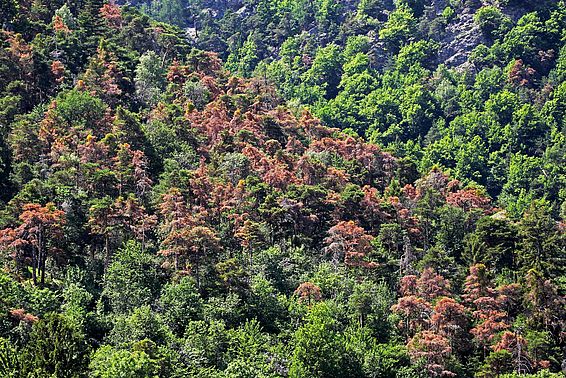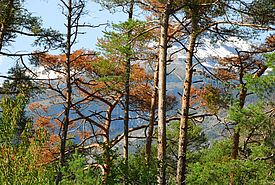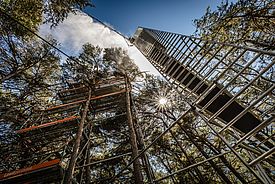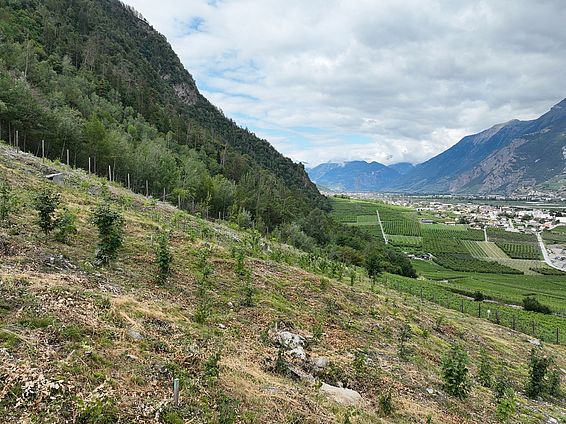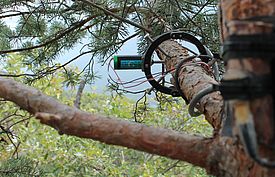Climate change will significantly alter the Swiss forests. This could jeopardise important forest services for humans, such as wood as a raw material or protection against natural hazards. WSL is researching these changes, developing scenarios and proposing solutions to the forestry sector and the population.
Climate change is progressing much faster in the Alps than in other regions of the world. In future, a number of tree species will no longer thrive optimally in their current locations, including the economically important spruce and, in certain locations, the beech, which is currently predominant on the Central Plateau, or the Scots pine, which is widespread in Valais. This has consequences for timber yield and revenue, the protective effect of the forest against natural hazards, biodiversity and also the landscape. The risk that the future forest will be less able to provide important services for humans due to climate change is increasing rapidly.
Drought causes trees to die
Since the 1990s, Scots pines have been dying in Valais because it has become too dry for them. WSL researchers have been studying the ecosystem processes in the Pfynwald, a dry pine forest near Leuk, since 2003. Among other things, they are irrigating some of the test areas with sprinklers, thereby doubling the natural precipitation of around 600 mm and thus also the amount of soil water available to the trees. A trial in which the irrigation was switched off again after 10 years showed that the pines benefited from the increased water availability. They grew more vigorously over several years than the dry climate would have led us to expect. The pines even pass on their "experience" to the next generation: if the parent trees were used to drought, the offspring also coped better with less water.
As climate change progresses and hot summers become more frequent, a new threat is emerging: rising air temperatures are drying out not only the soil but also the air. This atmospheric dryness puts additional pressure on the trees and also "sucks up" more water - the trees therefore evaporate more water. WSL researchers are investigating this phenomenon with a new, globally unique outdoor experiment. In addition to the sprinklers, they are also installing water vapour nozzles to manipulate air and soil dryness in combination and better understand how these two factors affect the trees and the forest.
Future-proof trees wanted!
Climate change is progressing faster than the forest ecosystem can adapt in order to continue to provide its services to humans. To advise foresters on which tree species will be best suited to which locations in the future, WSL researchers launched a major project in 2020: Together with local foresters, they planted 55,000 seedlings of various tree species in 57 test areas throughout Switzerland. WSL will follow their fate for the next 30 to 50 years in order to identify tree species that are equipped for the future.
Drought stress measured every ten minutes
Forests can only provide wood and store carbon dioxide (CO2) if they are growing. Increasing summer drought reduces the growth and survival of trees. The TreeNet monitoring network measures the water supply to trees in near real time and is therefore an early warning system for the onset of drought. Its data helps to assess weather extremes and their effects. This makes it possible to forecast the effects of climate change on the forest. One TreeNet application is the FORTE web application. It can be used to check whether Swiss forests are suffering from soil dryness, how great the risk of insect infestation is and how this affects the growth of individual tree species. From this, FORTE Future was developed, which shows how the potential distribution of tree species is likely to change with climate change.
Further publications around climate change
Contact
Links and documents
- Forest and climate change: https://www.wsl.ch/en/forest/forests-and-climate-change/
- TreeNet: https://treenet.info
- Pfynwald research platform: https://www.wsl.ch/pfynwald
- VPDrought project: https://www.wsl.ch/vpdrought
- Current forest condition: https://www.nccs.admin.ch/nccs/en/home/the-nccs/priority-themes/forest-functions-and-climate-change/current-forest-condition.html
- Tree species distribution in climate change: https://www.nccs.admin.ch/nccs/en/home/the-nccs/priority-themes/forest-functions-and-climate-change/future-forest-projections.html
- Future tree species for the Swiss forests: https://www.tree-app.ch/
Copyright
WSL and SLF provide image and sound material free of charge for use in the context of press contributions in connection with this media release. The transfer of this material to image, sound and/or video databases and the sale of the material by third parties are not permitted.
